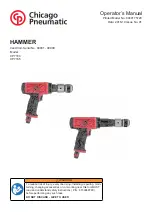
17
en
5.2 Additional safety precautions
5.2.1 Personal safety
a)
Hold power tool by insulated gripping surfaces, when
performing an operation where the cutting acces-
sory may contact hidden wiring or its own cord.
Cut-
ting accessory contacting a "live" wire may make expo-
sed metal parts of the power tool "live" and could give
the operator an electric shock.
b)
Wear ear protectors.
Exposure to noise can cause hear-
ing loss.
c)
Use auxiliary handle(s), if supplied with the tool.
Loss
of control can cause personal injury.
d)
Wear respiratory protection when the work causes
dust.
e)
Exercise your fingers during pauses between work
to improve the blood circulation in your fingers.
f)
Switch the tool on only once it has been brought into
the working position close to the workpiece.
g)
To avoid tripping and falling when working, always
lead the sypply cord, extension cord and dust extrac-
tion hose away tho the rear.
h)
The insert tool may become hot during use.
There
is a risk of burning the hands. Wear protective gloves
when changing insert tools.
i)
Always hold the tool securely, with both hands on
the grips provided.
j)
Operate the tool only as directed and only when it
is in faultless condition.
k)
Connect the tool to an external dust removal sys-
tem if the material to be cut produces dust hazardous
to health.
l)
Dust from material such as paint containing lead,
some wood species, minerals and metal may be harm-
ful. Contact with or inhalation of the dust may cause
allergic reactions and/or respiratory diseases to the
operator or bystanders. Certain kinds of dust are clas-
sified as carcinogenic such as oak and beech dust
especially in conjunction with additives for wood con-
ditioning (chromate, wood preservative). Material
containing asbestos must only be treated by spe-
cialists.
Where the use of a dust extraction device is
possible it shall be used. To achieve a high level of
dust collection, use a suitable vacuum cleaner of
the type recommended by Hilti for wood dust and/or
mineral dust together with this tool. Ensure that the
workplace is well ventilated. The use of a dust mask
of filter class P2 is recommended. Follow national
requirements for the materials you want to work
with.
m)
The tool is not intended for use by children, by
debilitated persons or those who have received no
instruction or training.
n)
Children must be instructed not to play with the tool.
5.2.2 Work area
a)
Ensure that the workplace is well lit.
b)
Ensure that the workplace is well ventilated.
Poor-
ly ventilated workplaces may be injurious to the health
due to exposeure to dust.
5.2.3 Electrical safety
a)
Before beginning work, check the working area (e.g.
with a metal detector) to ensure that no concealed
electric cables or gas and water pipes are present.
External metal parts of the tool may become live if,
for example, an electric cable is damaged inadvertenly.
This presents a serious risk of electric shock.
b)
Check the condition of the supply cord and its plug
connections and have it replaced by a qualified elec-
trician if damage is found. Check the condition of
the extension cord and replace it if damage is found.
Do not touch the supply in the event of it suffering
damage while working. Disconnect the supply cord
plug from the socket
. Damaged supply cords and
extension cords present a risk of electric shock.
c)
Dirty or dusty electric tools should thus be checked
at a Hilti service center at regular intervals, espe-
cially if used frequently for working on conductive
and properly used.
Use of dust collection can reduce dust-
related hazards.
5.1.4 Power tool use and care
a)
Do not force the power tool. Use the correct power tool for
your application.
The correct power tool will do the job better
and safer at the rate for which it was designed.
b)
Do not use the power tool if the switch does not turn it on
and off.
Any power tool that cannot be controlled with the switch
is dangerous and must be repaired.
c)
Disconnect the plug from the power source and/or the bat-
tery pack from the power tool before making any adjust-
ments, changing accessories, or storing power tools.
Such
preventive safety measures reduce the risk of starting the pow-
er tool accidentally.
d)
Store idle power tools out of the reach of children and do
not allow persons unfamiliar with the power tool or these
instructions to operate the power tool.
Power tools are dan-
gerous in the hands of untrained users.
e)
Maintain power tools. Check for misalignment or binding
of moving parts, breakage of parts and any other condition
that may affect the power tool’s operation. If damaged, have
the power tool repaired before use.
Many accidents are caused
by poorly maintained power tools.
f)
Keep cutting tools sharp and clean.
Properly maintained cut-
ting tools with sharp cutting edges are less likely to bind and are
easier to control.
g)
Use the power tool, accessories and tool bits etc. in accor-
dance with these instructions, taking into account the work-
ing conditions and the work to be performed.
Use of the pow-
er tool for operations different from those intended could result
in a hazardous situation.
5.1.5 Service
a)
Have your power tool serviced by a qualified repair person
using only identical replacement parts.
This will ensure that
the safety of the power tool is maintained.
Printed: 07.07.2013 | Doc-Nr: PUB / 5138188 / 000 / 00




































